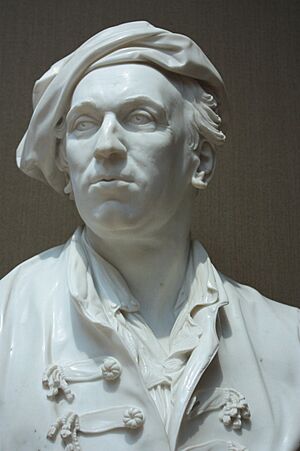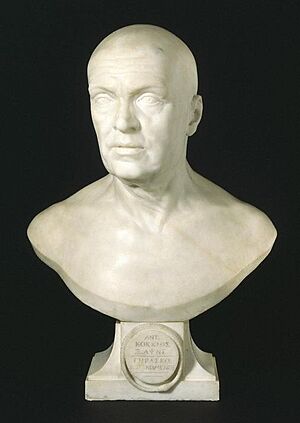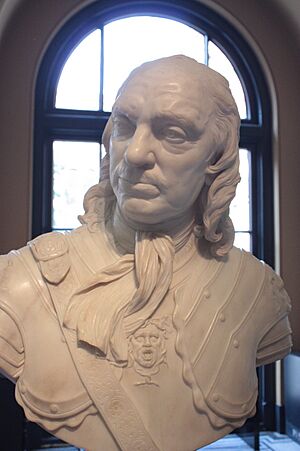Joseph Wilton facts for kids


Joseph Wilton RA (born July 16, 1722 – died November 25, 1803) was a famous English sculptor. He was one of the first people to help create the Royal Academy in 1768. He also served as the academy's third keeper, which was an important role.
Wilton created many sculptures, especially memorials for famous British people in Westminster Abbey.
Contents
Early Life and Training
Joseph Wilton was born in London, near Charing Cross. His father was a skilled plasterer who created beautiful decorations, including ceilings for the Foundling Hospital. Joseph's father wanted him to become a civil engineer. However, Joseph was very passionate about sculpture and decided to follow his own dream.
Wilton began his art training in Belgium with a sculptor named Laurent Delvaux. In 1744, he moved to Paris, France, to study at the Academy under Jean-Baptiste Pigalle.
Learning in Italy
In 1752, Joseph Wilton traveled to Italy with his friend, the sculptor Louis-François Roubiliac. He spent seven years there, first in Rome and then in Florence, learning how to sculpt with marble. While in Rome, he met and became friends with William Locke of Norbury, who became his first supporter. Locke even joined Wilton on his tour of Italy.
Like many artists of his time, Wilton studied ancient Roman and Greek sculptures. He made many plaster casts and marble copies of these classic artworks. Many of these copies later became part of the collection of Charles Lennox, 3rd Duke of Richmond. One of Wilton's most important works from this time is a marble bust of the doctor Antonio Cocchi, carved in 1755. This bust is now in the Victoria and Albert Museum.
While in Florence, Wilton met the painter Giovanni Battista Cipriani. When Wilton and the architect William Chambers returned to England in 1755, Cipriani came with them.
Becoming a Master Sculptor
Back in London, Joseph Wilton became a co-director of the Richmond House gallery. He also opened his own workshop. He became very busy, creating many busts (sculptures of heads and shoulders) and monuments.
Famous Works and Commissions
One of his well-known works is the memorial for James Wolfe in Westminster Abbey. Wilton also made at least two marble busts of Oliver Cromwell. He based these sculptures on a cast of Cromwell's face. One marble version and its original clay model are now at the Victoria and Albert Museum.
In 1761, Wilton received a special request to create a statue of King George III. More requests for similar statues followed, including one in 1766 for New York City. This huge statue showed the king riding a horse, dressed in Roman style. It was made of lead and covered in gold. It was sent to America and put up in Bowling Green, New York, in 1770. However, it was taken down by American patriots in 1776 during the American Revolution.
Wilton's other works included many important busts, monuments like the one for Stephen Hales in Westminster Abbey, and other carvings such as fireplaces and tables.
Later Life and Legacy
In 1768, when Joseph Wilton was at the height of his career, he became a founding member of the Royal Academy. This was a great honor. Around the same time, he inherited a large amount of money from his father. This new wealth meant he spent less time on sculpting.
By 1786, Wilton had to sell most of his belongings, and by 1793, he faced financial difficulties. Despite this, in 1790, he was appointed Keeper of the Royal Academy. He held this important position until he passed away in 1803. He was buried at St Mary the Virgin, Wanstead in east London.
Key Sculptures
- Monument to Admiral Temple West in Westminster Abbey (1757)
- Bust of Thomas Sydenham (1758)
- A Medici lion sculpture at Kedleston Hall (around 1760–1770)
- Monument to Stephen Hales in Westminster Abbey (1761)
- Bust of his friend Louis-François Roubiliac (1761)
- Gold State Coach (1762)
- Bust of Sir Isaac Newton in the Bodleian Library, Oxford (1762)
- Bust of Oliver Cromwell, Victoria and Albert Museum (1762)
- Monument to Sir Hans Sloane in the churchyard of Chelsea Old Church (1763)
- Monument to William Pulteney, 1st Earl of Bath in Westminster Abbey (1764)
- Monument to General James Wolfe in Westminster Abbey (1772)
- Monument to Sir James Steuart Denham in Westminster Abbey (1780)
- Monument to his own daughters in Chelsea Old Church (1781)
- Monument to Sir Archibald Campbell in Westminster Abbey (1795)
Fun Fact
The town of Wilton, New Hampshire in the United States is believed to have been named after Sir Joseph Wilton in 1762.



